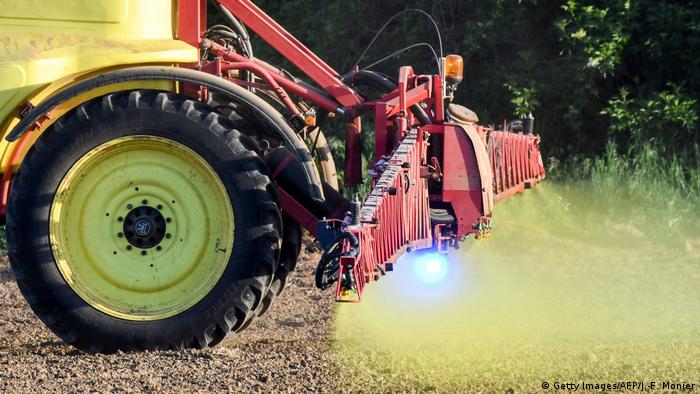forever and a day i will put this sort of info out there
Defending glyphosate: A 'Roundup' of German agribusiness sentiments
Monsanto's controversial weed killer Roundup is used widely by many agricultural firms across Germany. They say consumers are hardly aware of what it would mean to stop using the herbicide. Hardy Graupner reports.
![]()
Only a few kilometers west of Berlin, Dirk Peters runs a huge agricultural company called Agro-Farm Nauen, which is located in the rural state of Brandenburg surrounding the German capital.
As the chief executive of the agribusiness, he's responsible for the roughly 2,500 hectares of crops including wheat, barley, rye and oat. The firm also grows corn and sugar beets for its own biogas plant, which generates electricity and produces biomethane.
There are fields here as far as the eye can see, and as in most other agricultural businesses across the nation,
weeds are a nuisance. There's no denying that the latter eat into harvests as they deprive crops of nutrients.
Glyphosate part of cultivation scheme
Peters makes no secret of the fact that Monsanto's (Bayer's) glyphosate product Roundup is used here widely to give the crops a crucial headstart.
"The use of glyphosate is based on an agricultural cultivation strategy that we've adopted," Peters tells DW. "It's a non-selective herbicide that kills all broadleaf weeds and grasses that compete with crops," he explains.
The head of Agro-Farm Nauen, Dirk Peters, says it's not so easy to find a replacement for glyphosate
"We use it in particular on our 100 hectares of fields for the cultivation of sugar beets," he explains. "We have green fields in the fall to make sure they don't lie fallow — but in spring we use glyphosate to prepare the fields for the sugar beets and get rid of everything that could harm the future harvest."
Legally, Agro-Farm Nauen is on the safe side in doing so, with EU authorities having allowed the use of glyphosate in the bloc for another five years back in 2017. But the company is certainly aware of mounting criticism from environmental and consumer protection groups, which suggest German farmers could do without that herbicide.
"We're constantly faced with with accusations that we pour large quantities of glyphosate onto our fields, but that's complete nonsense," Peters says. "First, we wouldn't be able to afford it as the herbicide costs a lot of money, and secondly, farmers here know how to deal with glyphosate responsibly. Of course, there will always be the odd black sheep in the family, but I'm not aware of any such cases here in Brandenburg. We don't use the weed killer, if we don't have to, and there have been years when we didn't need to use it at all or only in very low quantities," he adds.
![]()
Sugar beets and weeds can't really live in peaceful coexistence, and Agro-Farm Nauen makes sure that weeds don't get the upper hand
"And let me point out that in our company we haven't used glyphosate at all for many years to protect crops that are ready for harvest."
Using plows instead?
Critics of the herbicide in Brandenburg are quick to
demand that weeds be removed mechanically, but Peters says they usually fail to mention the downsides of such an approach.
"Yes, another cultivation strategy would indeed be to remove the weeds mechanically with tractor-driven plows," Peters admits. "But that would cost a lot more energy and increase the use of diesel enormously and our CO2 emissions respectively. Food products would become more expensive," he notes. "And using plows extensively would harm our fields as it would worsen our already existing wind erosion problems."
Nonetheless, it looks like the use of glyphosate in agriculture in the EU is on its way out despite the period of grace it was given two years ago. So, is there anything to replace it?
"I'm almost certain that industry has already something in the drawer to replace glyphosate, but I'm just as certain that it would be more expensive," Peters argues. "There's a little biologist and chemist in each of us farmers, so we'll probably be able to concoct something of our own and get the right agents together to help us in a post-glyphosate world."
The head of Agro-Farm Nauen told DW that he'd followed
the court trials in the US where some complainants had already secured damages as jury members were convinced that Roundup had played a role in the plaintiffs' developing cancer.
There's just one study I know of that concludes that glyphosate may cause cancer while so many other studies don't come to the same conclusion — that says it all, Peters emphasizes. "Looking at the jury trials in the US, I have my misgivings that the jury members really have the necessary knowledge about the subject for a fair verdict."
![]()
Agriculture is not the only beneficiary of glyphosate
Defending glyphosate: A 'Roundup' of German agribusiness sentiments | DW | 27.05.2019
Riesling wine, holding out between pesticides and climate change
Climate change, new pests and diseases are threatening Riesling wine. Warmer temperatures are forcing winemakers to increase the use of plant protection methods, namely pesticides.
![]()
Martin Schömann proudly shows the mix of wild plants growing alongside his vines on the steep slopes of the German wine region of Moselle. Riesling vineyards stretch as far as the eye can see.
"Despite being a wine monoculture, we foster biodiversity in the soil," Schömann told DW. "Plants aren't the enemy, they're our friends."
Riesling wine, holding out between pesticides and climate change | DW | 27.05.2019
Bees and pesticides
The European Union's food safety watchdog has confirmed that pesticides harm bee populations. Several studies have shown that neonicotinoids affect the brains and bodies of bees and other insects, changing their behavior and reducing their fertility and lifespan.








































-w.jpg)














